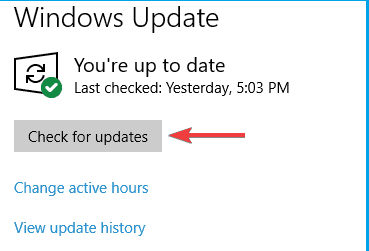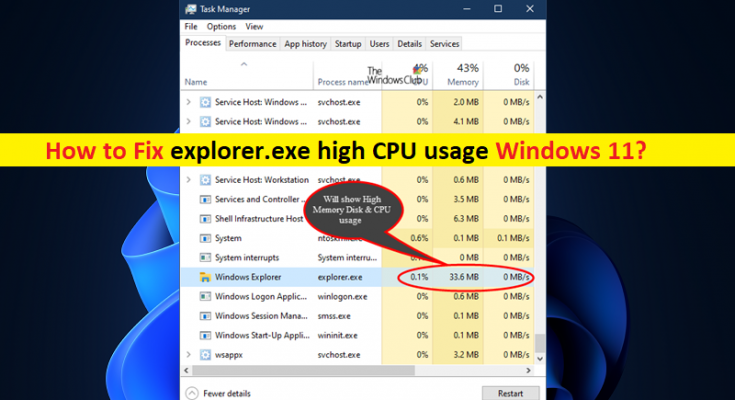Tips to fix explorer.exe high CPU usage Windows 11:
If you are facing explorer.exe high CPU usage Windows 11, then you are in right-place for the solution. Here, you are provided with easy steps/methods on How to fix explorer.exe high CPU usage Windows 11. Let’s starts the discussion.
‘explorer.exe high CPU usage issue in Windows 11’:
Windows Explorer or File Explorer or Explorer.exe is part of Microsoft Windows Operating System. It serves as main UI component which allows users to browse files, interact with the taskbar and other elements, etc. You would have to manually input commands via Command Prompt or Task Manager, without Explorer/Windows Explorer. Disabling explorer.exe (Windows Explorer or File Explorer) would make the operation and hanging of any Windows OS as much worse experience.
However, several users reported they faced explorer.exe high CPU usage Windows 11 or explorer.exe high CPU usage issue on their Windows 11/10 computer. When you open Task Manager app in Windows PC in order to check which program/process is causing system performance slowdown issue, you may experience explorer.exe/Windows Explorer/File Explorer is showing higher percentage under CPU usage section in Task Manager.
There could be several reasons behind the issue including the corruption in system files or registry, or in system image, corruption in hard disk drives or bad hard disk sectors, malware or viruses infections in computer, interference of problematic applications/extensions installed in your device, and other system issues. It is possible to fix the issue with our instructions. Let’s go for the solution.
How to fix explorer.exe high CPU usage Windows 11?
Method 1: Fix explorer.exe high CPU usage issue with ‘PC Repair Tool’
‘PC Repair Tool’ is easy & quick way to find and fix BSOD errors, DLL errors, EXE errors, problems with programs/applications, malware or viruses infections in computer, system files or registry issues, and other system issues with just few clicks. You can get this tool through button/link below.
Method 2: Run SFC scan and chkdsk scan
You can run SFC scan and chkdsk scan in computer to repair corruption in system files and corruption in hard disk drives or bad sectors, and resolve this issue as well.
Step 1: Type ‘cmd’ in Windows Search Box and press ‘SHIFT + ENTER’ keys on keyboard to open ‘Command Prompt as Administrator’
Step 2: Type the following commands one-by-one and hit ‘Enter’ key after each to execute.
sfc /scannow
chkdsk /f :X
Step 3: Once executed, restart your computer and check if the issue is resolved.
Method 3: Run Disk Cleanup tool

You can run Disk Cleanup tool to remove old and temporary files in computer and fix the issue.
Step 1: Open ‘Disk Cleanup’ tool via Windows Search Box
Step 2: Select the System Drive like ‘C: drive’ from dropdown, and hit ‘Ok’ button
Step 3: Your PC will now scan the selected drive. This process usually takes a couple of seconds. Select the file you want to remove and click ‘Ok’.
Step 4: If you want, you can click ‘Clean System Files’ button in order to remove additional files. Once finished, check if the issue is resolved.
Method 4: Disable or uninstall cloud storage clients
This issue can be occurred due to cloud storage services like Dropbox or OneDrive Clients installed in your device. You can fix the issue by disabling cloud storage services like Dropbox or OneDrive in computer in order to fix. If disabling cloud storage service didn’t work, you can uninstall cloud storage service in order to fix, and then check if it works for you.
Method 5: Update Windows OS

Updating Windows OS to latest version can resolve the issue.
Step 1: Open ‘Settings’ app in Windows PC via Windows Search Box and go to ‘Windows Update’ and click ‘Check for updates’ button
Step 2: Download and install all available updates in computer and once updated, restart your computer and check if the issue is resolved.
Method 6: Perform Clean Boot

You can perform clean boot operation in computer in order to fix.
Step 1: Open ‘System Configuration’ app in Windows PC via Windows Search Box
Step 2: Click ‘Services’ tab, check ‘Hide all Microsoft Services’ checkbox and hit ‘Disable All’ button
Step 3: Now, click ‘Startup’ tab, and click ‘Open Task Manager’, right-click on each startup item in task manager, and select ‘Disable’ to disable them and then close Task manager.
Step 4: Finally, click ‘Apply > Ok’ button on System Configuration app to save the changes and check if the issue is resolved.
Method 7: Clear contents of Temp folder
Step 1: Open ‘File Explorer’ in Windows PC and go to ‘C: > Windows > Temp’ folder
Step 2: Delete all files inside Temp folder. Press ‘CTRL + SHIFT + ESC’ keys on keyboard to open ‘Task Manager’, find and right-click on ‘Windows Explorer’ process, and select ‘Restart’ to restart it.
Step 3: Once done, check if the issue is resolved.
Method 8: Delete Audioses.dll
Step 1: Open ‘File Explorer’ and go to ‘C: > Windows > System32’ folder
Step 2: Find and move ‘Audioses.dll’ file to desktop. Now, go to ‘C: > Windows > Sys > WOW64’ folder
Step 3: Find audioses.dll file and move it to a different folder. Once done, check if it works for you.
Conclusion
I hope this article helped you on How to fix explorer.exe high CPU usage Windows 11 with easy ways. You can read & follow our instructions to do so. That’s all. For any suggestions or queries, please write on comment box below.



